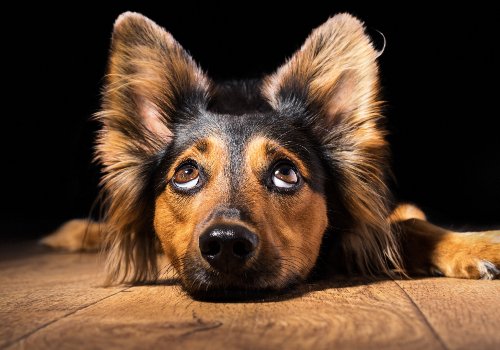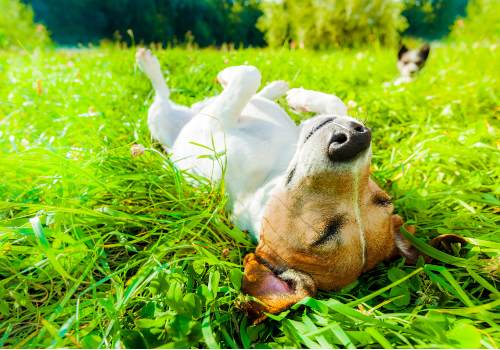Ever look at your dog staring off into space and wonder what he’s thinking about?
What’s going on in that brain of his? Is he reviewing knowledge, conjuring up memories… or is he just processing sensory input in the moment?
Dogs behave so differently from humans that it’s easy to assume that the way they think is also different from us.
But while we don’t know everything about canine cognition, what we do know is that they’re more like us than many people think.
It’s time to get inside your dog’s head and find out how he thinks — there’s plenty of surprises hidden in that noggin!
Brains Behind the Scenes: Dog Brains vs. Human Brains

First things first, let’s take a look at the structure of a dog’s brain and see how it compares to a human’s.
Size: Does It Actually Matter?
One difference is immediately obvious: a dog’s brain is much smaller than a human’s.
That’s true whether you’re comparing raw sizes (human brains are around the size of a grapefruit, while dog brains are around the size of tangerine at most) or brain-to-body ratios (for humans, it’s around 1:40, but for dogs, it’s around 1:125).
Now, brain size doesn’t dictate intelligence — at least, not all types of intelligence. Across species, science has shown no correlation between brain size and social intelligence, inferential reasoning, or physical reasoning.
But brain size does play a role in executive functioning — things like self-control and short-term memory. A study conducted by the University of Arizona showed that large dogs (who have larger brains) tend to have better executive functioning than small dogs.
From this, we can infer that a dog’s thought process is more impulsive than a human’s, and dogs probably forget things much more easily than we do.
But that’s about all we can gather from brain size alone. To learn more, we need to go deeper…
Appearance: Entering the (Brain) Fold
Picture a brain and you probably picture a lump covered in squiggly folds.
The more folds a brain has, the higher its total surface area. And the higher the surface area, the more neurons the brain can hold — which, theoretically, means better cognition.
Our brains are folded very densely, providing plenty of space for neurons and allowing us to feel complex emotions, perform complicated calculations, and think at an overall higher level than other animals.
A dog’s brain, on the other hand, is smoother in appearance. There are still folds, but they appear looser and there aren’t as many of them, meaning a lower surface area — and fewer neurons.
Because of these limitations, dogs aren’t able to think as complexly as we do. They probably think about fewer things simultaneously and don’t perform the same types of reasoning or planning that we do.
Structure: All the Right Parts

Every part has a purpose, influencing how we think — and how well we do it.
The hippocampus, for instance, handles memories and learning, while the basal ganglia control motor skills, executive functioning, and emotions. Your amygdala processes fear and analyze threats, and the brainstem regulates involuntary processes like breathing and heartbeat.
Structure-wise, a dog’s brain is strikingly similar to ours. All those same parts are there, and although they’re not always in the same places, they appear to serve the same functions — though they sometimes do so in different ways.
Auditory and Vocal Processing
Both species, for example, have a region of the brain that specializes in vocal processing. On an MRI, this area of the human brain lights up when human voices are heard — and for dogs, it lights up when barking, growling, or whining is heard.
What’s more, in both species, the area lights up in very similar ways depending on the type of vocalization. A happy or content vocalization produces one type of activity, while angry or fearful vocalizations produce another.
However, this vocal processing area appears more finely tuned in humans: in our brains, it lights up almost exclusively in response to the human voice. But in dogs, it frequently lights up in response to non-vocal sounds, suggesting that the canine brain isn’t as adept at differentiating between speech and other noises.
Scent Processing
We communicate primarily through auditory and visual means, and our brains show it: our visual cortex and auditory cortex are both large and dense, able to handle huge amounts of complex sensory input.
Dogs, however, don’t have great vision, so their visual cortex takes up far less of their brain than ours does.
And while they certainly use their hearing to make their way through the world, they mainly utilize a sense that we usually keep on the back burner: scent.
Here the dog brain differs dramatically from the human brain: the canine olfactory (scent) system makes up 2% of the total brain weight. Ours takes up a measly 0.03%, showing just how much of a dog’s thinking is informed by the scents it encounters.
Visual Processing

It’s fairly common knowledge that compared to our vision, a dog’s vision isn’t as advanced. Dogs see fewer colors than we do, they’re quite nearsighted, and they probably can’t perceive as fine detail as we can.
Analysis of the canine visual cortex reveals more differences — but also some similarities. Both dogs and humans use one part of the brain to recognize members of their own species, and another to recognize members of other species.
However, while human brains responded differently to images of faces than to images of the backs of heads, dog brains responded in a similar manner to both.
This suggests that dogs organize their visually-obtained information differently than we do. A dog’s thoughts about what it sees are probably more focused on the bigger picture (am I looking at another dog?) than the details (what does this other dog’s face look like?).
Rewards and Motivation
The caudate nucleus is a little nugget of tissue in the middle of the brain that handles many different functions: impulse control, procedural learning, and motor skills.
But it’s perhaps most well-known for its role in the brain’s reward system. It’s loaded with dopamine — the “pleasure hormone” — that gets released when you’re rewarded with something.
All animals have a caudate nucleus and a reward system — it’s essential to survival. But the level of dopamine, and thus the intensity of activity in the caudate nucleus, varies from species to species.
Dogs and humans alike have highly active caudate nuclei. In dogs, it’s been shown to light up when they smell their owners and when they’re shown a hand signal associated with treats.
You can see evidence of this when you reach for the toy box or the treat bag. The promise of pleasure causes a surge of dopamine that overwhelms his thought processes — at that moment, nothing else matters except that sweet reward.
So What Do Dogs Think About?
We know now that dogs think quite similarly to us. On a basic level, their brains process sensory inputs, form and retain memories, and produce emotional responses to these things.
And structurally, their brains are more like ours than they are different — though with some key variations that line up with what we know about their sensory experiences.
But what does that mean for your dog’s day-to-day thoughts?
Pleasure on the Brain

We know that dogs are single-minded when it comes to pleasure. They’re highly attuned to any indication that they might get a treat, a belly rub or a long play session, so they likely spend a lot of time on the alert for these signs.
This means that their thoughts are probably occupied with good things: food, toys, and, of course, you.
In this way, a dog’s thoughts mirror ours quite closely. We spend much of our day thinking about pleasurable things, such as the delicious meal we’re going to have for dinner, our favorite TV show’s latest episode, and warm memories of time spent with our loved ones.
Your Pup’s Perception
How these thoughts come about is another mystery. But given what we know about a dog’s senses, we can surmise that much of your dog’s thinking takes place in the olfactory region of his brain.
The lingering scent of this morning’s breakfast, the enticing odor of the garbage can, the smell of the air before it rains… all of these things travel from your dog’s nose to his brain, informing him of the world around him. They shape his thoughts in the same way that sights and sounds shape ours.
A Simpler, Social Mind
Of course, the smaller size and relative smoothness of your dog’s brain indicate that whatever’s going on in there, it’s probably not as complex as what’s going on in yours.
You can plan for things in advance by recalling memories of similar events and utilizing your bank of knowledge. But that kind of reasoning takes a lot of neurons and a highly-developed frontal lobe — and we’ve got dogs beat by leaps and bounds on both counts.
So it’s safe to say that multi-step plans, complex correlations, and advanced language processing aren’t your dog’s forte.
Researchers have ranked dogs at around the level of a two-year-old toddler in terms of language capabilities, and in terms of math abilities, they’re on par with three- or four-year-old humans.
But as far as social intelligence goes, dogs operate at around the level of a human teenager. That’s the type of intelligence they needed to survive over millions of years of evolution.
So maybe your dog isn’t the next Mark Twain or Albert Einstein. But when he’s off in his own little world, he’s probably thinking about all the people and animals he knows, recalling good times with them — and looking forward to new ones.

